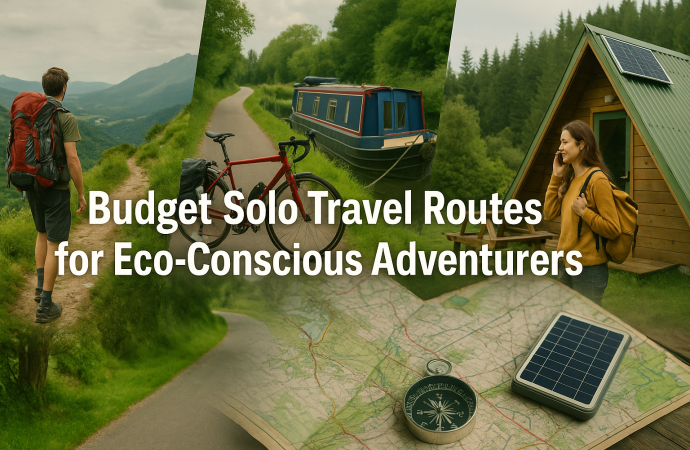Introduction Traveling alone on a slim budget once meant crowded dorm rooms and fast-food dinners. Today eco-conscious adventurers can roam the planet, cut costs, and protect nature at the same time. Low-impact buses, community homestays, and rail passes open routes that feel rich in experience yet light on the wallet. This guide reveals budget solo
Introduction
Traveling alone on a slim budget once meant crowded dorm rooms and fast-food dinners. Today eco-conscious adventurers can roam the planet, cut costs, and protect nature at the same time. Low-impact buses, community homestays, and rail passes open routes that feel rich in experience yet light on the wallet. This guide reveals budget solo travel routes for eco-conscious explorers, explaining why each path keeps emissions down, supports locals, and treats your bank account kindly. You will discover affordable rail loops in Europe, slow-boat journeys in Asia, and bus corridors in Latin America—plus the small daily habits that shrink your footprint even further. Pack light, carry curiosity, and let’s plan a greener getaway.
What Makes a Route Eco-Friendly and Budget-Wise?
Before mapping any trail, understand the two pillars of “green on a budget.”
Low-Carbon Transport
Walking, cycling, trains, and shared buses release fewer greenhouse gases per mile than flights or private cars. Choosing routes centered on these modes cuts both emissions and ticket costs.
Community-Based Stays
Staying with family-run guesthouses or cooperatives keeps money inside the region, funds conservation, and often costs less than chains. Many offer free bikes, refill stations, and organic breakfasts—extra perks at no extra fee.
Keep these criteria in mind as we explore seven standout itineraries across the globe.
Route 1: Iberian Rail Loop—Portugal & Spain

Image by: Yandex.com
Why Go
The railway grid between Porto, Lisbon, Seville, and Madrid is dense, scenic, and cheaper than most Western Europe lines. Night trains eliminate hotel costs and carbon-heavy flights.
Eco Highlights
- Solar-powered stations in Lisbon’s Oriente hub
- Electric tram rides in Porto’s old town
- Urban bike-share systems along the Tagus River trails
Budget Breakdown
| Item | Daily Cost (USD) | Notes |
|---|---|---|
| Regional Rail Pass | 15 | Single-country Portugal pass, four travel days in one month |
| Hostel Dorm | 20 | Certified by Green Key program |
| Food | 18 | Market picnics of pão, olives, fruit |
| Local Transport | 5 | Tram or metro day ticket |
| Total | 58 | Under $60/day with rail discounts |
Route 2: The Balkan Green Corridor—Slovenia to Montenegro
Why Go
Former Yugoslav nations host untouched forests, Adriatic coastlines, and well-priced eco-lodges. Buses run on biodiesel blends, and hiking trails connect towns easily.
Eco Highlights
- Lake Bled car-free shoreline
- Tara Canyon white-water raft companies that offset emissions
- Farm-to-table dinners in Montenegro’s Durmitor villages
Cost-Cutting Tips
- Buy a Balkan Flexipass for intercity trains.
- Volunteer one day at an organic farm to earn a night’s stay.
- Share cab rides from trailheads using local ride apps.
Route 3: Maya Bus Circuit—Southern Mexico & Guatemala
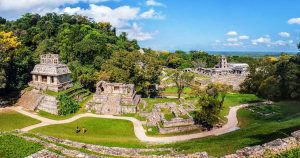
Image by: Yandex.com
Why Go
Long-distance ADO and Linea Dorada buses link heritage cities and rain-forest reserves. Border crossings are smooth, and homestays around Lake Atitlán teach sustainable farming for a small fee.
Eco Highlights
- Bike tours to cenotes near Valladolid
- Solar-powered hostels in Palenque
- Reforestation treks outside Antigua
Safety & Budget
Stick to first-class buses overnight (about $25 per eight-hour leg). Day meals—beans, tortillas, tropical fruit—average $10. Total spend hovers around $50/day.
Route 4: Northeast India Tea & Trek Path—Assam to Sikkim
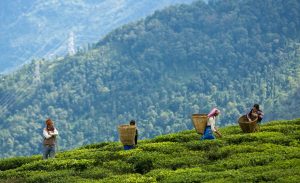
Image by: Yandex.com
Why Go
This less-traveled region rewards patience with orchids, organic tea gardens, and Himalayan homestays. Slow trains and share jeeps cut emissions versus domestic flights.
Eco Highlights
- Kaziranga’s electric jeep safaris
- Community-managed tea estates in Darjeeling
- Zero-plastic village policies in Yuksom
Money Savers
Sleep in monastery guest rooms for donations (about $8). Drink filtered water at stations—carry a steel bottle and sterilizing pen.
Route 5: Mekong Slow-Boat Drift—Thailand, Laos, Cambodia
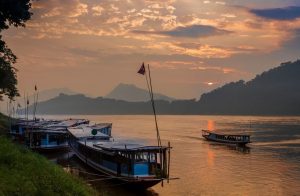
Image by: Yandex.com
Why Go
Two-day slow boats from Chiang Khong to Luang Prabang use small diesel engines at low RPM, emitting less per passenger than regional jets. Onward routes by bus and bike hug the Mekong to Phnom Penh.
Eco Highlights
- Wildlife guides raising river-dolphin funds in Kratie
- Bamboo guesthouses with compost toilets on Don Det island
- Cycling tours of Angkor’s back gates, avoiding tuk-tuk lines
Sample Budget
Boat ticket $40, dorms $6-$10, street noodles $5, bike rental $2. Total about $45/day.
Route 6: Pacific Northwest Rail-Trail Loop—USA & Canada
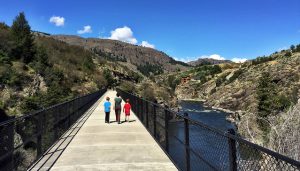
Image by: Yandex.com
Why Go
Amtrak Cascades and VIA Rail join Seattle, Vancouver, and Portland. From each city, a lattice of rail-trail bike paths leads to organic farms, forests, and craft markets.
Eco Highlights
- Electric ferries between Victoria and the mainland
- Farm stays near Mount Hood with solar showers
- Vancouver’s zero-waste eateries offering discounts for BYO containers
Budget Hacks
Use the North-west USA Rail Pass (seven travel days for $299). Rent used gear from REI’s Good & Used program rather than flying equipment in.
Route 7: Trans-Tasman Working-Holiday Hop—New Zealand South Island
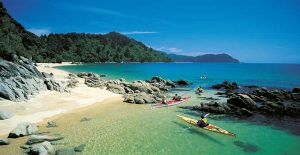
Image by: Yandex.com
Why Go
A year-long working-holiday visa lets solo travelers exchange farm or hostel work for lodging. Intercity buses run on bio-diesel blends, and shared vans operate carbon-offset schemes.
Eco Highlights
- Wwoofing on permaculture farms near Nelson
- Glacier country cycleways built from recycled plastic mats
- Predator-free sanctuaries that host volunteers for free dorm beds
Financial Outline
Work-trade covers accommodation. Groceries average $12/day if you cook. Budget buses add $200 total for one-month roaming.
Essential Gear for Low-Impact Solo Travel
| Item | Purpose | Eco Edge |
|---|---|---|
| Refillable water bottle with filter | Skip single-use plastic | Saves money in any climate |
| Compact bamboo cutlery set | Eat street food sustainably | Lightweight and TSA-friendly |
| Solar power bank | Charge devices on trains | Reduces hostel plug scramble |
| Quick-dry towel & clothesline | Wash on the go | Cuts laundromat fees |
| E-reader loaded with guides | Lighten pack by 1 kg | No paper waste |
Everyday Habits to Shrink Your Footprint
Pack Light, Travel Light
A 7-kg carry-on forces mindful choices and keeps bus luggage fees down. Less weight equals lower fuel burn.
Eat Local, Plant-Heavy
Choose vegetarian specials and market produce. They cost less and avoid the emissions tied to imported meat.
Embrace “Leave No Trace”
Carry trash until you find recycling bins. Many developing regions lack street bins, so tourists must shoulder the responsibility.
Offset Last-Mile Flights
If an ocean crossing is unavoidable, book nonstop routes and purchase verified carbon offsets—then stay longer to make that flight count.
Planning Resources and Apps
- Rome2Rio: Finds bus, train, and ferry combos with emission data.
- HappyCow: Maps plant-based eateries worldwide.
- Couchsurfing Hangouts: Meet locals hosting free eco-walks.
- Omio: Books European rail and coach tickets in one wallet.
- Trail Wallet: Tracks daily spend and flags budget overruns.
Frequently Asked Questions
Is solo travel safe in these regions?
Common sense—secure bags, avoid deserted streets at night—goes far. Join hostel WhatsApp groups to share routes and taxis.
Do I need special insurance?
Look for policies that add adventure-sport coverage (rafting, trekking) and offer extra days if you extend spontaneously.
How do I meet people while staying eco-minded?
Attend hostel family dinners, volunteer clean-up events, and free walking tours. Conversations blossom when you pitch in together.
Future Outlook: Greener Routes Ahead
Rail booms are planned across Southeast Asia, hydrogen buses are coming to Chile’s tourist circuits, and Europe aims to revive more night trains by 2030. As infrastructure turns greener, budget options should multiply. Start honing low-impact habits now to ride the wave of sustainable mobility later.
Conclusion
Traveling solo on a budget no longer means sacrificing your environmental values. By choosing rail loops, bio-diesel buses, slow boats, and community stays, you can see the world while guarding the planet and your wallet. The seven routes here—from Iberian trains to Mekong boats—offer adventure, culture, and low-carbon credibility. Pack light, eat local, volunteer often, and track spending. Adventure awaits wherever rails roll, rivers flow, or buses rumble—just step aboard and keep your footprint small.
Call-to-Action: Ready to map your own low-impact journey? Download our free eco-budget route planner and start booking greener transport today.

